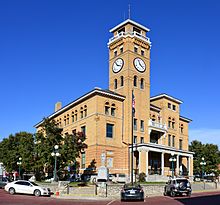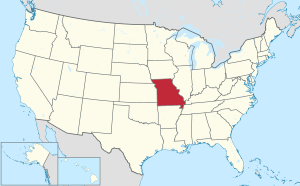Cass County, Missouri facts for kids
Quick facts for kids
Cass County
|
||
|---|---|---|

County courthouse in Harrisonville
|
||
|
||

Location within the U.S. state of Missouri
|
||
 Missouri's location within the U.S. |
||
| Country | ||
| State | ||
| Founded | March 3, 1835 | |
| Named for | Lewis Cass | |
| Seat | Harrisonville | |
| Largest city | Kansas City | |
| Area | ||
| • Total | 702 sq mi (1,820 km2) | |
| • Land | 697 sq mi (1,810 km2) | |
| • Water | 5.7 sq mi (15 km2) 0.8% | |
| Population
(2020)
|
||
| • Total | 107,824 | |
| • Density | 153.60/sq mi (59.30/km2) | |
| Time zone | UTC−6 (Central) | |
| • Summer (DST) | UTC−5 (CDT) | |
| Congressional district | 4th | |
Cass County is a county in the western part of Missouri, a state in the United States. It's part of the big Kansas City metropolitan area.
In 2020, about 107,824 people lived here. The main town, or county seat, is Harrisonville. However, a small part of Kansas City, Missouri is also in Cass County.
The county started in 1835 and was first called Van Buren County. In 1849, it was renamed after Lewis Cass. He was a U.S. Senator from Michigan and later ran for president.
Contents
History of Cass County
Early Native American Tribes
Long ago, the area around Harrisonville was home to Native American tribes. These included the Osage, Quapaw, Omaha, Ponca, and Kansa tribes. They spoke similar languages.
The Kansa tribe lived from the Kansas-Missouri River down to what is now Bates County. They were neighbors with the Osage tribe. It seems neither tribe had a permanent village right in Cass County.
Other tribes like the Shawnee and Lenape (also called Delaware) also lived here. The Lenape had moved west from the East Coast. This happened because new settlers kept moving onto their lands.
In 1818, the U.S. gave land in Missouri to the Lenape. But they had to give it back in 1825 when Missouri became a state. Then, they moved to a reservation in Kansas. Some Lenape had already moved to Texas.
First European Settlers
The first European-American settler in the Harrisonville area was James Lackey in 1830. Other early settlers included Humphrey Hunt, John Blythe, and Dr. Joseph Hudspeth. Lackey built a cabin and farmed a small area. This land was later chosen for the county seat.
In 1835, the Missouri government officially picked the town site. The first county court met on September 14, 1835. It was held at James McClellan's home. The county was known as Van Buren County back then.
Founding of Harrisonville
In 1837, the town of Harrisonville was planned out. Commissioners Enoch Rice, Francis Prine, and Welcome Scott helped with this. They met with Martin Rice, the county surveyor.
The town was laid out with four streets: Wall, Pearl, Lexington, and Independence. The first town lots were sold on June 12, 1837. Lots facing the public square cost $20, and others were $10.
People wanted to name the town "Democrat," but it was decided against. Instead, it was named after Albert G. Harrison, a U.S. Representative from Missouri. The first house in town was built by Jason L. Dickey in 1836. The first jail was built in 1838.
The first church in Harrisonville was started on October 8, 1835. It was called Hopewell or New Hope Baptist.
Railroad History and Challenges
Later, Harrisonville got railroad lines like the Missouri Pacific and the Frisco. There was a big problem with how the railroads were funded. The county had agreed to help pay for the Pacific Railroad.
But then, the company secretly issued new bonds. This meant the county might have to pay for the same bonds again. People in Cass County were very angry about this. They felt cheated by the company and some officials.
A newspaper in Harrisonville was burned by an angry group of people. This event showed how upset the community was.
Civil War Impact
By 1860, just before the Civil War, Harrisonville had about 675 people. During the war, in 1863, the town was emptied. This was part of an effort by the United States forces. They wanted to reduce support for rebel groups in the area.
Most of the buildings in Harrisonville were burned down, including the jail. Fort Harrisonville was a Union army base for a short time in 1863. It helped protect families who supported the Union.
You can learn more about the county's history at the Pleasant Hill Historical Society Museum. It's located in Pleasant Hill.
Geography of Cass County
The U.S. Census Bureau says Cass County covers about 702 square miles. Most of this (697 square miles) is land. About 5.7 square miles (0.8%) is water.
Neighboring Counties
Cass County shares borders with these counties:
- Jackson County (north)
- Johnson County (east)
- Henry County (southeast)
- Bates County (south)
- Miami County, Kansas (west)
- Johnson County, Kansas (northwest)
It's interesting that Cass County borders two counties named Johnson County. One is in Missouri, and the other is in Kansas!
Main Roads
These are some of the major highways in Cass County:
 Interstate 49
Interstate 49 U.S. Route 71
U.S. Route 71 Route 2
Route 2 Route 7
Route 7 Route 58
Route 58 Route 291
Route 291
Public Transportation
- Jefferson Lines provides bus services.
People of Cass County
| Historical population | |||
|---|---|---|---|
| Census | Pop. | %± | |
| 1840 | 4,693 | — | |
| 1850 | 6,090 | 29.8% | |
| 1860 | 9,794 | 60.8% | |
| 1870 | 19,296 | 97.0% | |
| 1880 | 22,431 | 16.2% | |
| 1890 | 23,301 | 3.9% | |
| 1900 | 23,636 | 1.4% | |
| 1910 | 22,973 | −2.8% | |
| 1920 | 21,536 | −6.3% | |
| 1930 | 20,962 | −2.7% | |
| 1940 | 19,534 | −6.8% | |
| 1950 | 19,325 | −1.1% | |
| 1960 | 29,702 | 53.7% | |
| 1970 | 39,748 | 33.8% | |
| 1980 | 51,029 | 28.4% | |
| 1990 | 63,808 | 25.0% | |
| 2000 | 82,092 | 28.7% | |
| 2010 | 99,478 | 21.2% | |
| 2020 | 107,824 | 8.4% | |
| U.S. Decennial Census 1790-1960 1900-1990 1990-2000 2010-2020 |
|||
In 2000, there were about 82,092 people living in Cass County. There were 30,168 households and 22,988 families. The population density was about 117 people per square mile.
Most people (95.62%) identified as White. About 1.42% were Black or African American. Around 2.21% of the population was Hispanic or Latino.
About 38.10% of households had children under 18 living with them. The average household had 2.69 people. The average family had 3.09 people.
The median age in the county was 36 years old. About 28.40% of the population was under 18. About 11.70% were 65 or older.
The median income for a household was about $49,562. For a family, it was about $55,258.
Religion in Cass County
Cass County is sometimes seen as being on the northern edge of the "Bible Belt." This means that evangelical Protestantism is a very common religion here.
The most common religious groups are Southern Baptists (43.71%). Next are Roman Catholics (17.42%) and United Methodists (11.07%).
2020 Census Information
| Race | Num. | Perc. |
|---|---|---|
| White (NH) | 89,406 | 83% |
| Black or African American (NH) | 4,904 | 4.6% |
| Native American (NH) | 502 | 0.47% |
| Asian (NH) | 841 | 0.8% |
| Pacific Islander (NH) | 78 | 0.07% |
| Other/Mixed (NH) | 6,510 | 6% |
| Hispanic or Latino | 5,583 | 5.2% |
Education in Cass County
Public Schools
Here are some of the school districts in Cass County:
Full K-12 school districts
- Archie R-V School District
- Belton 124 School District
- Drexel R-IV School District
- Harrisonville R-IX School District
- Holden R-III School District
- Kingsville R-I School District
- Lee's Summit R-VII School District
- Lone Jack C-VI School District
- Raymore-Peculiar R-II School District
- Sherwood Cass R-VIII School District
- Pleasant Hill R-III School District
- Midway R-I School District
Elementary school districts:
- East Lynne 40 School District
- Strasburg C-III School District
Individual Schools
- Archie R-V School District – Archie
- Cass County Elementary School (PK-06)
- Archie High School (07-12)
- Belton 124 - Belton High School (10-12)
- Drexel R-IV School District – Drexel
- Drexel Elementary School (K-06)
- Drexel High School (07-12)
- East Lynne School District No. 40 – East Lynne
- East Lynne Elementary School (PK-08)
- Harrisonville R-IX School District – Harrisonville
- Early Childhood Center (PK-K)
- Harrisonville Elementary School (01-05)
- McEowen Elementary School (04-05)
- Harrisonville Middle School (06-08)
- Harrisonville High School (09-12)
- Midway R-I School District – Cleveland
- Midway Elementary School (K-06)
- Midway High School (07-12)
- Pleasant Hill R-III School District – Pleasant Hill
- Pleasant Hill Primary School (PK-02)
- Pleasant Hill Elementary School (03-04)
- Pleasant Hill Intermediate School (05-06)
- Pleasant Hill Middle School (07-08)
- Pleasant Hill High School (09-12)
- Raymore-Peculiar R-II School District – See article
- Sherwood Cass R-VIII School District – Creighton
- Sherwood Elementary School (K-05)
- Sherwood Middle School (06-08)
- Sherwood High School (09-12)
- Strasburg C-3 School District – Strasburg
- Strasburg Elementary School (K-08)
Private Schools
- Hope Baptist Christian School – Pleasant Hill (01-12) – Baptist
- Harrisonville Christian School – Harrisonville (PK-08) – Nondenominational Christian
- Training Center Christian School – Garden City (PK-12) – Pentecostal
- Heartland High School & Academy – Belton (PK-12) – Baptist
- Blue Ridge Christian School South – Belton (PK-06) – Nondenominational Christian
Public Libraries
- Cass County Public Library
Communities in Cass County
Cities
- Archie
- Belton
- Cleveland
- Creighton
- Drexel
- East Lynne
- Freeman
- Garden City
- Harrisonville (county seat)
- Kansas City (partly)
- Lake Annette
- Lake Winnebago
- Lee's Summit (partly)
- Peculiar
- Pleasant Hill
- Raymore
- Strasburg
Villages
Census-Designated Places
Unincorporated Communities
Famous People from Cass County
- Robert C. Bell, a federal judge
- Angelica Bridges, an actress, model, and singer
- Delmer Brown, a Japanologist (expert on Japan)
- Emmett Dalton, from the famous Dalton Gang
- Carson Coffman, an AFL player
- Chase Coffman, an NFL tight end
- Paul Coffman, an NFL player
- Tyler Farr, a country music singer-songwriter
- Brutus Hamilton, a decathlete and track and field coach
- Ben Hardaway, an artist and director during the "Golden Age of American animation"
- Vicky Hartzler, a U.S. Representative from Missouri
- Kevin Hern, a U.S. Representative from Oklahoma
- Ewing Kauffman, a businessman who started Marion Laboratories and owned the Kansas City Royals baseball team
- Chris Koster, a former Attorney General of Missouri
- Tammy Faye Messner, a televangelist
- Carrie Nation, a leader in the temperance movement (which worked to stop alcohol use)
- Edward Capehart O'Kelley, known for killing Robert Ford
- Tate Stevens, the 2012 winner of The X Factor TV show
- Oad Swigart, a professional baseball player
- Glenn Wright, a professional baseball player
See also
 In Spanish: Condado de Cass (Misuri) para niños
In Spanish: Condado de Cass (Misuri) para niños


